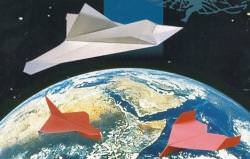This is from the "why is anyone spending money on this?" department. Researchers from the University of Tokyo have teamed up with members of the Japan Origami Airplane Association to develop a paper aircraft capable of surviving the flight from the International Space Station to the Earth's surface. The only problem is that no one knows where the paper airplane might land, and no tracking device is in the works to be used. So, the plan is to do an experiment with no way of gathering any data.
The researchers began testing the strength and heat resistance of an 8 centimeter (3.1 in) long prototype on January 17 in an ultra-high-speed wind tunnel at the University of Tokyo. In the tests, the origami glider -- which is shaped like the Space Shuttle and has been treated to withstand intense heat -- will be subjected to wind speeds of Mach 7, or about 8,600 kilometers (5,300 miles) per hour.
The researchers claim this paper airplane will come down more slowly than say, a real spacecraft, and it is not expected to burn up on re-entry.
No launch date has been set for the paper spaceplane, but Shinji Suzuki, an aerospace engineering professor at the University of Tokyo, is thinking ahead. "We hope the space station crew will write a message of peace on the plane before they launch it," says Suzuki. "We don't know where in the world the plane will land, but it would be nice to send a message to whoever finds it."
Even if the paper airplane does make it through the atmosphere unscathed, given that our planet is 70% water, don't hold out much hope for it being found.
Original News Source:
Pink Tentacle
 Universe Today
Universe Today
